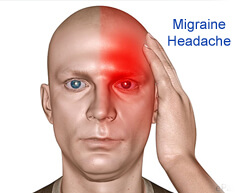Headache
 headache or cephalalgia is pain anywhere in the region of the head or neck. It can be a symptom of a number of different conditions of the head and neck. Headaches can result from a wide range of causes both benign and more serious. Brain tissue itself is not sensitive to pain as it lacks pain receptors. Rather, the pain is caused by disturbance of the pain-sensitive structures around the brain. Nine areas of the head and neck have these pain-sensitive structures, which are the cranium (the periosteum of the skull), muscles, nerves, arteries and veins, subcutaneous tissues, eyes, ears, sinuses and mucous membranes. There are a number of different classification systems for headaches. The most well-recognized is that of the International Headache Society. Headache is a non-specific symptom, which means that it has many possible causes, including fatigue and sleep deprivation, stress, the effects of medications and recreational drugs, viral infections and common colds, head injury, rapid ingestion of a very cold food or beverage, dental or sinus issues, and many more.
headache or cephalalgia is pain anywhere in the region of the head or neck. It can be a symptom of a number of different conditions of the head and neck. Headaches can result from a wide range of causes both benign and more serious. Brain tissue itself is not sensitive to pain as it lacks pain receptors. Rather, the pain is caused by disturbance of the pain-sensitive structures around the brain. Nine areas of the head and neck have these pain-sensitive structures, which are the cranium (the periosteum of the skull), muscles, nerves, arteries and veins, subcutaneous tissues, eyes, ears, sinuses and mucous membranes. There are a number of different classification systems for headaches. The most well-recognized is that of the International Headache Society. Headache is a non-specific symptom, which means that it has many possible causes, including fatigue and sleep deprivation, stress, the effects of medications and recreational drugs, viral infections and common colds, head injury, rapid ingestion of a very cold food or beverage, dental or sinus issues, and many more.
Treatment of a headache depends on the underlying cause, but commonly involves pain killers. Some form of headache is one of the most commonly experienced of all physical discomforts.
Welcome to the MNT Knowledge Center, your source for our most detailed content on specific conditions and subjects. Click through to Knowledge Center Home to read more.
A headache is defined as "a pain or ache in the head...It accompanies many diseases and conditions, including emotional distress."
Headaches are one of the most common symptoms that can be experienced. Most people will experience a headache at some point of their lives.2 They can affect anyone regardless of age and gender.
 The World Health Organization (WHO) reports that around 47% of the world's adult population will have experienced a headache within the last year. As well as being symptoms of other conditions, headache disorders can lead to the development of other illnesses. Depression is three times more common in individuals with severe headaches than healthy people.
The World Health Organization (WHO) reports that around 47% of the world's adult population will have experienced a headache within the last year. As well as being symptoms of other conditions, headache disorders can lead to the development of other illnesses. Depression is three times more common in individuals with severe headaches than healthy people.
Headache is a broad term that encompasses many different things. Headaches are pains that occur in any region of the head; they can occur on both sides the head or be isolated to a certain location.
Headaches can radiate across the head from a central point or have a pincering vise-like quality. They can be sharp, throbbing or dull, appear gradually or suddenly and last for multiple days or less than an hour. There are multiple ways to define headaches. The International Headache Society (IHS) categorize headaches as primary headaches or secondary headaches, depending on what has caused them. Primary headaches are stand alone illnesses which are caused directly by the overactivity of, or problems with, structures in the head that are pain-sensitive. This includes the blood vessels, muscles and nerves of the head and neck, as well as chemical activity taking place inside the brain.
Primary headaches can occur when pain-sensitive structures in the head do not work properly.
Common primary headaches include migraines, cluster headaches and tension headaches.

Planning your medical trip to India is a very simple process with Spine and Neuro Surgery Hospital India
- You just need to fill in our enquiry form and one of our executive will contact you soon.
- +91-9325887033 Call us at the given to contact number for any assistance.
- Complete information regarding surgery is provided on our website.
There are other types of headache that are considered to be primary headaches, although on occasion they can be symptoms of another illness and, therefore, secondary conditions. These headaches can be categorized under the following associations:
- Direct physical stimuli, such as temperature and external pressure
- Pain over the scalp (epicranial)
- Physical exertion
- Other miscellaneous headaches.
- Secondary headaches
Secondary headaches are headaches that are symptoms of another condition that stimulates the pain-sensitive nerves of the head. There are a vast number of different conditions that can cause secondary headaches, ranging in severity from an alcohol-induced hangover to a brain tumor.
Secondary headaches can be the result of serious conditions such as stroke, but can equally be a consequence of eating cold food too quickly.
In addition to those two examples, the following list should serve to illustrate the variety of different conditions that can cause secondary headaches:
- Blood clots
- Brain freeze (ice cream headaches)
- Carbon monoxide poisoning
- Concussion
- Dehydration
- Glaucoma
- Influenza
- Overuse of pain medication (rebound headaches)
- Panic attacks
- Stroke
As headaches can be a symptom of a serious condition, it is advised that medical advice should be sought if headaches are experienced that are more severe than may have previously been experienced.
For example, if the headache is more painful and disruptive than previous headaches, worsens or fails to improve with medication or is accompanied by other symptoms such as confusion, fever, sensory changes and stiffness, a health care provider should be contacted.
In 2009, 10% of males and 22% of females in the US reported experiencing migraines or severe headaches, according to the Centers for Disease Control and Prevention. Now, a new study suggests older individuals who suffer from migraines may be more likely to have silent brain injury and have double the odds of experiencing "silent strokes," compared with those who do not have migraines.
Migraines and other types of headaches, such as tension headache and sinus headache, are painful. Migraine symptoms include a pounding headache, nausea, vomiting, and light sensitivity and are treated with antinausea drugs and abortive or preventive medications. Headache remedies include pain relievers.
The brain itself is not sensitive to pain, because it lacks pain receptors, also called nociceptors. However, several areas of the head and neck do have nociceptors, and can thus sense pain. These include the extracranial arteries, middle meningeal artery, large veins, venous sinuses, cranial and spinal nerves, head and neck muscles, the meninges, falx cerebri, parts of the brainstem, eyes, ears, teeth and lining of the mouth. Pial arteries, rather than pial veins are responsible for pain production.
 Headaches often result from traction to or irritation of the meninges and blood vessels. The nociceptors may be stimulated by head trauma or tumors and cause headaches. Blood vessel spasms, dilated blood vessels, inflammation and/or infection of meninges and muscular tension can also stimulate nociceptors and cause pain. Once stimulated, a nociceptor sends a message up the length of the nerve fiber to the nerve cells in the brain, signaling that a part of the body hurts.
Headaches often result from traction to or irritation of the meninges and blood vessels. The nociceptors may be stimulated by head trauma or tumors and cause headaches. Blood vessel spasms, dilated blood vessels, inflammation and/or infection of meninges and muscular tension can also stimulate nociceptors and cause pain. Once stimulated, a nociceptor sends a message up the length of the nerve fiber to the nerve cells in the brain, signaling that a part of the body hurts.
Primary headaches are more difficult to understand than secondary headaches. The exact mechanisms which cause migraines, tension headaches and cluster headaches are not known. There have been different theories over time which attempt to explain what happens in the brain to cause these headaches.
In 2005, the International Headache Society released its latest classification system for headache. Because so many people suffer from headaches and because treatment sometimes is difficult, it was hoped that the new classification system would help health care professionals make a specific diagnosis as to the type of headache and allow better and more effective options for treatment.
Hospitals such as in Nagpur provide specialized treatment for Neuro treatment. The cost of surgery is comparatively quite low in Spine and Neuro Surgery Hospital.
Get Low Cost Headache Treatment in India
We offer free assistance to international patients to find best medical treatment in India. We offer low-cost, world-class medical treatment in India, coordinated by a team of experienced service industry professionals
Please post a query to know about low cost treatment options at top India hospitals
Click Here
